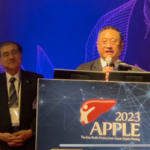Editor’s Note:
Stereotactic Body Radiotherapy (SBRT), as a novel radiotherapy technique, has achieved encouraging results in the treatment of liver cancer. It not only improves local tumor control but also reduces distant metastases caused by tumors. Additionally, it minimizes radiation therapy-related complications, enhancing the quality of life for patients after treatment. However, how to maximize the role of SBRT in comprehensive liver cancer treatment is a topic worthy of further exploration. At the 13th Asia-Pacific Primary Liver Cancer Expert Meeting (APPLE 2023), Dr. Zhaochong Zeng and his team from Zhongshan Hospital, Fudan University, China, presented two studies selected for oral and poster presentations, focusing on improving the effectiveness of SBRT and reducing radiation therapy-related adverse reactions, which attracted significant attention at the conference. In this article, Dr. Zeng shares insights into these two studies.

Impact of Different Radiotherapy Fractionation Patterns on Peripheral Lymphocytes and Their Prognostic Value in HCC Patients
Background:
Hepatocellular carcinoma (HCC) is one of the most common malignancies in China. Radiotherapy (RT) is an effective treatment for liver cancer, offering high local control rates. RT not only directly kills liver cancer cells by inducing DNA damage but also has systemic immune-modulatory effects. On one hand, RT enhances the immunogenicity of tumor cells, improving anti-tumor immune responses. On the other hand, RT can reduce the total number of peripheral blood lymphocytes (TLC), weakening the anti-tumor immune response and correlating with poor prognosis in HCC patients. Thus, reducing the incidence of RT-induced lymphopenia (RIL) is crucial. Our team retrospectively compared the impact of SBRT and conventional fractionated radiotherapy (CFRT) on TLC and its subgroups in HCC patients, as well as analyzed the correlation between RIL and the prognosis of HCC patients.
Methods:
A retrospective analysis was conducted on 137 HCC patients who received RT at our hospital from July 2011 to December 2018 (excluding patients with distant metastases, dual tumors, follow-up <6 months, and those who received other local treatments within one month before RT). Relevant indicators were collected one week before RT, on the first day after RT, and at two months post-RT. The study compared the impact of SBRT and CFRT on TLC and lymphocyte subgroup levels in HCC patients and employed univariate and multivariate Cox regression analysis to explore prognostic factors for overall survival (OS) in patients.
Results:
Among the enrolled patients, 84 received SBRT, and 53 received CFRT. The 1-year and 2-year OS rates were 80.0% and 55.0% overall, with 93.0% and 77.6% in the SBRT group and 66.0% and 38.0% in the CFRT group, respectively. Multivariate analysis results showed that tumor size >4.5 cm, portal vein tumor thrombosis, multiple lesions, and post-RT CD4+ T cell count <231/μL, and CD8+ T cell count <179/μL were adverse prognostic factors for HCC patients (Figure 1).

Both SBRT and CFRT could reduce TLC, but severe RIL (<0.5×109/L) occurred in 70.0% of CFRT patients, while only 23.0% of SBRT patients experienced severe RIL. Binary logistic analysis revealed that the number of fractions was an independent factor for RIL. Patients receiving SBRT had higher TLC and lymphocyte subgroup levels one day and two months post-treatment compared to those receiving CFRT (P<0.05, Figure 2).

For the SBRT group, there were significant differences in CD4+ T cell and CD8+ T cell counts between patients with OS >2 years and those with OS <2 years (P<0.05, Figure 3).

Conclusion:
Post-radiotherapy lymphopenia is an important factor in the poor clinical prognosis of HCC patients. Choosing an appropriate radiotherapy regimen and technique, such as SBRT, may be key to reducing the incidence of RIL.
Silencing of CircRNA-0033351 Suppresses Hepatic Stellate Cell Activation and Cytokine Storm Induced by Radiation Therapy for Primary Liver Cancer
Background:
Radiotherapy (RT) is an essential component of comprehensive treatment for liver cancer, but radiation-induced liver damage (radiation-induced liver disease, RILD) is one of the most significant dose-limiting adverse reactions of liver RT. Studies have shown that inhibiting the activation and proliferation of hepatic stellate cells may be a primary strategy for mitigating RILD. Traditional two-dimensional (2D) culture models are single-layer in vitro growth systems, limiting the observation of the role of cells in chronic liver diseases such as liver damage or fibrosis. In contrast, three-dimensional (3D) cell culture technology more accurately simulates the in vivo microenvironment, including cell interactions, cell-extracellular matrix interactions, and is increasingly used in various cell science research.
Circular RNAs (circRNAs) are a class of non-coding RNA molecules with a special circular structure. Current research suggests that circRNAs are closely related to the development of various diseases. CircRNAs have several advantages over linear nucleic acid molecules as targets: they are highly conserved, tissue-specific, and stable, making them potential new tumor biomarkers and therapeutic targets. However, the role of circRNAs in RILD development remains largely unknown.
Methods:
In preliminary experiments, researchers used circRNA second-generation sequencing and real-time quantitative polymerase chain reaction (qRT-PCR) to identify circDYNC1H1 as a key molecule in the RILD process. They verified the circular structure and cellular localization of circDYNC1H1 through agarose gel electrophoresis, cell immunofluorescence, and nuclear-cytoplasmic separation experiments. Subsequently, they explored the mechanism of circDYNC1H1 using a 3D sphere model, cell viability assays, enzyme-linked immunosorbent assay (ELISA) experiments, bioinformatics predictions, dual-luciferase assays, cell immunofluorescence co-localization experiments, and western blot experiments.
Results:
This study found that circDYNC1H1 is a covalently closed circular RNA located on chromosome 14, consisting of 12 exons, primarily located in the cytoplasm. Furthermore, circDYNC1H1 expression significantly increased with time after radiotherapy. In vitro 3D
sphere model cell experiments demonstrated that downregulating circDYNC1H1 significantly reduced the viability of LX-2 cells, as well as the release of pro-inflammatory cytokines such as IL-1β, IL-6, IL-8, IL-17, and TNF-α. Moreover, through multiple databases and cell recovery experiments, the authors demonstrated that in the 3D sphere model experiment of LX-2 cells formed after radiotherapy, miR-708-5a could partially reverse the effect of circDYNC1H1 on the release of pro-inflammatory factors.

Conclusion:
This study successfully constructed a 3D sphere model of LX-2 cells. The research suggests that silencing circDYNC1H1 to alleviate RILD induced by radiotherapy presents a new treatment strategy for clinical practice. The study is ongoing, and the authors plan to further explore the mechanism and prospects of circDYNC1H1 with more in vivo and in vitro experiments.
Reference :
1. Yuan Zhuang, Ping Yang, Yi-xing Chen, Shi-suo Du, Zhao-chong Zeng. Effects of Stereotactic Body Radiotherapy versus Conventional Fractionated Radiotherapy on Circulating Lymphocyte Levels in Patients with Hepatocellular Carcinoma. APPLE 2023 Abstract PE-882.
2. Hao Niu, Li Zhang, Zhao-Chong Zeng. Silencing of CircRNA-0033351 Represses Hepatic Stellate Cells Activation and Cytokine Storm Induced by Radiation Therapy for Primary Liver Cancer. APPLE 2023 Abstract OP-22


